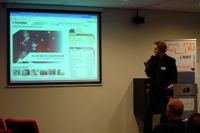
This category has always drawn many entries. Also the subject is wide ranging. This year it varied from a necrology of Pope John Paul the Second to She Spot, a soft erotic site for women. But also the museums were present: the famous Rijksmuseum and the virtual Egyptian museum. With Registry of Yesterday (Het Register van de Dag van Gister), old folks get the opportunity to record stories in text, sound and photographs and video by means of a multimedia desk. But there were also broadcast entries: Visual radio, a system for kids to produce news programs; Netherlands 4, a web television channel for public television and Fabchannel, the internet podium of the famous pop concert hall Paradiso. A related entry was the Pop encyclopaedia on CD-ROM. In the section Culture there were three interesting entries: national monument Camp Vught, about a concentration camp in Vught near Den Bosch; Maroc – 5000 years of culture, a website accompanying an exhibition on Maroc in Amsterdam; Panorama Alkmaar, a site in the framework of 750 year city rights. A special entry was the dream of Cornelius Lely, a Dutch water engineer; the DVD showed how this engineer worked on providing The Netherlands with polders.
The three nominations received the following jury statements:
www.fabchannel.com
Paradiso decided five years ago to launch Fabchannel, because of decreasing media attention for live music. Fabchannel now broadcasts concerts, festivals, lectures and competitions on the Internet, in sound and vision. The objective of this channel is to promote live music. Paradiso put a team of specialists together under the name “Fabchannel Foundation”. This team developed a streaming video portal with Flash and PHP technologies. Many of the concerts and events in Paradiso can be watched live on this website. Also on-demand broadcasts can be requested from the archive. This archive presently encompasses 320 registrations and is constantly growing. There is, besides know artists, also attention for lesser known talent. The bands and artists are from all over the world. About 50 percent of the visitors are from the Netherlands, the other half comes from abroad. All content is free and registering. Because of this a concert is only three clicks away. Fabchannel is completely built in Flash, while for the video streams Windows Media has been chosen. A selection can be made between a high- or low quality stream, so that the site is also accessible for dial-up users.

Jury pitch of the Fabchannel representative
www.mijnpaus.nl
In 2004, BOOS was asked by the Dutch broadcast station KRO/RKK to build a dynamic website with a necrology of Pope John Paul the Second. The story of his life is told by means of images, text, sound and video. This personal story of the producer leaves enough room for the visitor to form his own opinion about the late Pope. BOOS is a Dutch multimedia company specialised in developing for new media, especially in the area of interactive storytelling. BOOS was a nominee last year for Europrix.nl 2004 with the entry “Bomers the Bishop”. The website MijnPaus.nl is divided in 5 chapters: Introduction, Life, Character, Points of view and Send-off. A pop-up screen with a video is automatically presented at the start of every chapter. The first chapters give comprehensive information about the life and ideas of Pope John Paul the Second. The website contains subtle animations which give the site a unique look. The images supporting the text are in the form of animated slideshows, which contribute to the dynamic feel of the website. In the last chapter the visitors are offered to sign a condolences’ register. The website is mainly produced in Flash. The videos, which are opened in the pop-up screens are done in Windows Media format.
www.rijksmuseum.nl
In order to make the rich collection of the famous Rijksmuseum in Amsterdam accessible to a large audience worldwide, a dynamic website has been developed in which full-screen images of masterpieces from the collection are prominently present. The production of this website was assigned to Fabrique, a design bureau for graphic design, new media, industrial design and spatial design. On the website people can browse through the entire collection of the Rijksmuseum. Visitors can view detailed information about the works of art and the numerous artists. It’s also possible to view high resolution pictures of the countless works of art. Sliding panels, made from images of master pieces, are part of the navigation. That is what makes it possible to playfully browse through the comprehensive/wide collection. By means of a search action it is possible to search through the website, the collection, the web shop as well as the library catalogue. This is possible because of the links between the various internal databases. In addition to the collection there is also information available about the Rijksmuseum and its structural remodeling which is taking place. The image and text information about the different works of art are saved in XML-format, whereby content and lay-out are separated. When a piece of art goes on loan to another museum, wherever in the world, it is possible to integrate the content about this artwork in their on website, thanks to the use of XML. To keep the system requirements low and to avoid confronting the user with Flash, dynamic HTML was chosen. Flash has been selected for the advanced presentations. These presentations make also use of the XML structure.
In the end Fabchannel was chosen as the winner in this category. The concert channel has broadened its reach from the Amsterdam to the world. The interface is very easy; in a few simple clicks a concert, band or musician can be reached. But especially the innovative technology of the media player is interesting as it lays a basis for a video on demand service.

No comments:
Post a Comment